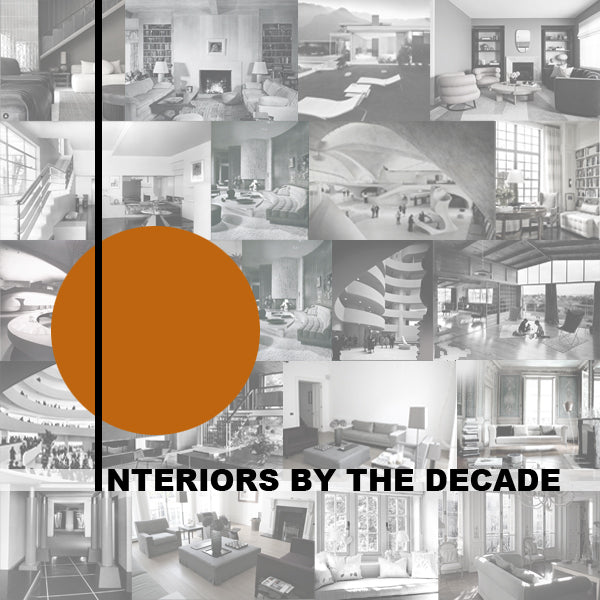
History Repeats Itself

The quote " History Repeats Itself" couldn't be more fitting when it comes to Interior Design styles and trends. It's an interesting time for the decorative arts as we experience a shift towards more chunky, rounded pieces. The influence of art deco and bauhaus design is evident.
Art Deco

Art Deco was introduced at the Exposition Internationale des Arts Decoratifs et Industriels Modernes in Paris in 1925. Some of the characteristics of Art Deco originated in France in the mid to late 1910's via the Ballets Russes, an experimental ballet troupe in Paris headed up by the Russian artistic director, Sergei Diaghilev.

The Ballets Russes had a look and feel that was completely unique and unlike anything anyone had seen before.
Mayan Influence

The Eastern Columbia Building

Elsie de Wolfe

"Simplicity, suitability and proportion" - Elsie de Wolfe
Elsie de Wolfe, also known as Lady Mendl is credited as being the first person to use the title of interior decorator. Elsie was born in New York in 1865 and died in Versailles, France in 1950. She worked with numerous celebrity clients and collaborated with famed designer Tony Duquette.
Marlene Dietrich

Elsie de Wolfe's design of Marlene Dietrich's home in Los Angeles is a study in Art Deco design and Hollywood Glamour.
Zebra and Black Panther with Cacti

Commissioned mural titled Zebra and Black Panther with Cacti by portrait artist & muralist, Charles Baskerville
Sketch London Tea Room


Sardi's NYC
Bauhaus

The Bauhaus school was founded in Weimar, Germany in 1919 by architect Walter Gropius, an icon of modern architecture. Bauhaus was rooted in craftsmanship and accessibility in contrast to the opulent style and expensive materials of Art Deco that catered to the wealthy.

Walter Gropius's philosophy was to employ craftspeople to collectively produce art, furniture, architecture, theatre, typography & weaving into a modern synthesis. Steel, glass & masonry were the materials of choice.
A New Era

In 1925, the Bauhaus School moved from Weimar to Dessau. Walter Gropius designed the campus which came to exemplify the Bauhaus style.
Ludwig Mies van der Rohe

In 1930, Ludwig Mies van der Rohe took over as the school's artistic director after a short slightly contentious term by Swiss architect Hannes Meyer.

Bauhaus Berlin (1932-1933)

By the early 30's, as the Nazi party rose to power, The Bauhaus school's everyman philosophy was seen as a threat to the fascist Nazi party.
In 1932 rather than cave into the Nazi's demands, Mies van der Rohe moved the school from Dessau to an abandoned telephone factory in Berlin-Steglitz to avoid detection.
Unfortunately, The Bauhaus School in Berlin would not last. In 1933, the Nazi's arrested several staff members. Rather than cooperate Mies van der Rohe made the decision to permanently close the school.
The White City

In the early 30's dozens of German Jewish architects who studied at The Bauhaus fled to Israel. In 1933 many of these architects were commissioned to design housing in Tel Aviv.
The result being what became known as the White City due to the buildings white facades.

The Thermometer Building in Tel Aviv designed by German Jewish Architect Yehuda Luilka in 1936.
The 1940's & The Polar Bear Suite

Mid-Century Modern



Postmodernism
Postmodern architecture emerged in the 60's as a reaction to the clean lines and supposed "lack of variety in modern architecture".


Postmodern Architecture

Michael Graves

Architect and product designer Michael Graves had a large influence on Postmodern architecture and product design. His 9093 tea kettle ws born out of the Tea and Coffee Piazza project in the 1970's. The Italian housewares company, Alessi invited 11 architects, none of whom had previously worked in industrial design, to design a tea and coffee service. The 9093 kettle is still popular today.
The Memphis Group


The Revival of Postmodern Design

One good thing about styles that become revived is that they can be refined and improved. While I'm not a big fan of postmodern design, I do like this modern interpretation by Arent & Pyke. The pop of salmon pink, the graphic rug and chunky shapes are all reminiscent of the style.
Everything old is new again
As Jonathan Swift wrote in an essay in 1710, "everything old is new again". Those of us who collect vintage furnishings & antiques appreciate the history and quality these pieces can bring to a modern aesthetic. By embracing the old while also reimagining the past, we can create looks that feel fresh and modern while also timeless.

Hi William,
For some reason Shopify doesn’t allow the writer of the blog to respond to comments. Isn’t that grand? I appreciate your comment. Upon further inspection, you are correct. It does appear most historians believe Frank Lloyd Wright was the inspiration for Howard Roark although some publications mention Mies Van Der Rohe as possible inspiration – https://www.architectural-review.com/essays/reputations/howard-roark-1928-1942, Thank you for taking the time to read my post.
Anything I have ever read suggests that Howard Roark was patterned after Frank Llyod Wright, not Mies